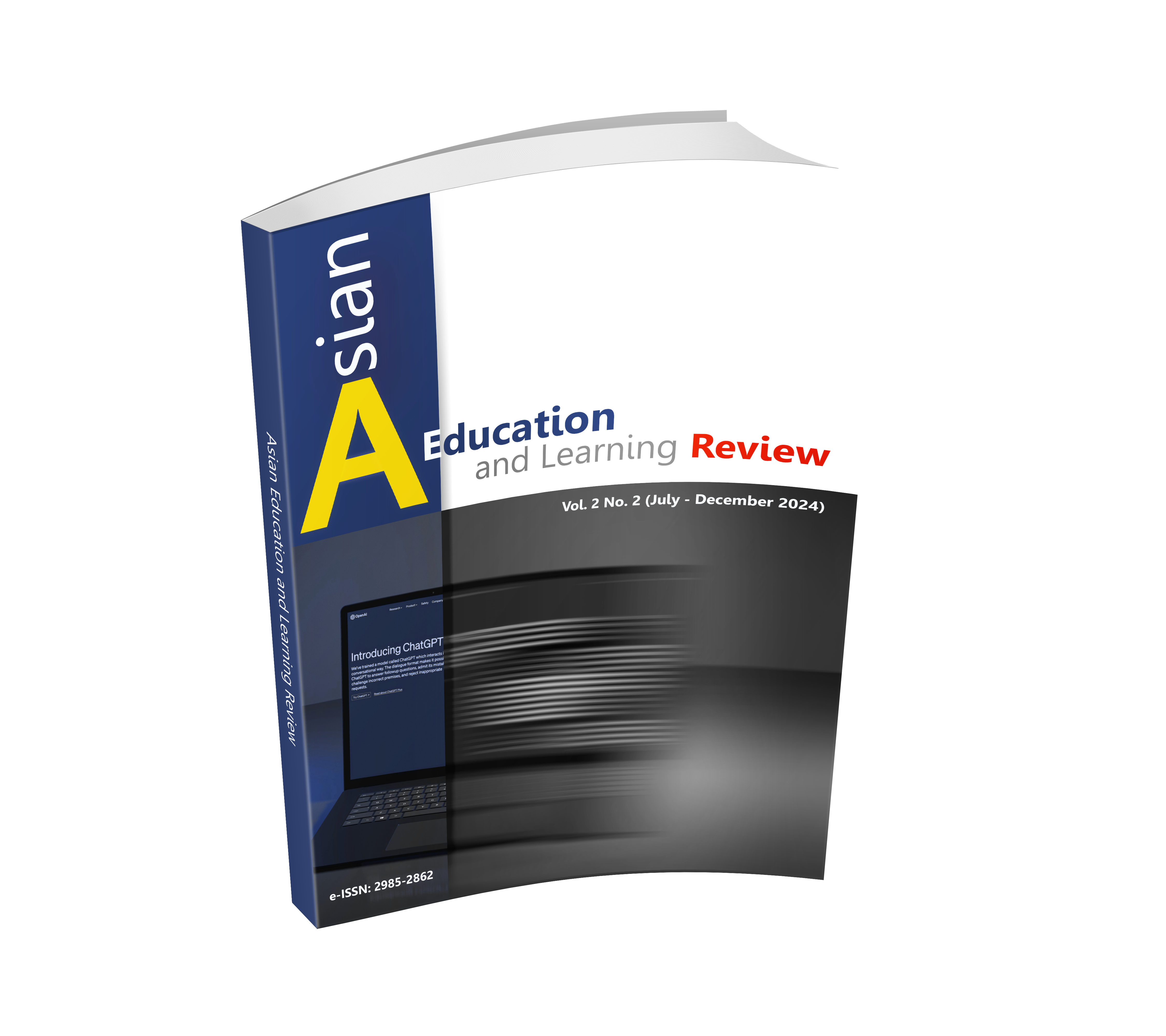THE INTEGRATION ON TRADITIONAL AND COMMUNICATIVE METHODS IN THAI LANGUAGE TEACHING AT GUIZHOU MINZU UNIVERSITY, CHINA
DOI:
https://doi.org/10.14456/aelr.2024.8Keywords:
Traditional Teaching Method, Communicative Language Teaching, Thai Language Teaching, Guizhou Minzu UniversityAbstract
This study aimed to address the challenges and opportunities in Thai language teaching at Guizhou Minzu University, China by integrating traditional and communicative methods. The specific purposes included 1) to explore the current state of Thai language instruction at the university, focusing on teaching methods and challenges, and 2) to propose effective strategies that enhance students’ communicative proficiency while respecting traditional educational practices. A mixed-methods approach was employed, incorporating surveys and interviews with 200 non-Thai students, ten non-Thai teachers, 80 Thai students, and 5 Thai teachers at Guizhou Minzu University with purposive sampling. The data analysis revealed significant challenges arising from the predominance of traditional teaching methods, which emphasise knowledge transmission over the development of communicative competence. Despite efforts to introduce Communicative Language Teaching (CLT), practical constraints such as limited Thai proficiency among non-native instructors, traditional educational norms, examination requirements, class sizes, and student interest hinder effective implementation. The findings highlight the feasibility and benefits of integrating traditional and communicative methods in Thai language education. This hybrid approach not only upholds academic rigor but also enhances students’ communicative skills, addressing. The study concludes with practical recommendations for implementing these strategies at Guizhou Minzu University, aiming to inspire educational advancements and meet evolving societal needs.
Downloads
References
Baek, J. (2017). A Study on the effective usage of task-based language teaching for improving communicative competence. Studies in Linguistics, 42, 369-393.
Bax, S. (2003). The end of CLT: A context approach to language teaching. ELT Journal, 57(3), 278-287.
Belinda, R., & Raja, P. (2021). Modifying PPP in promoting communicative language teaching to improve the students’ English communicative competence. International Journal for Innovation Education and Research, 9(8), 351-365.
Brandl, K. (2007). Communicative language teaching in action: Putting principles to work. New Jersey: Phil Miller.
Burnaby, B., & Sun, Y. (1989). Chinese teachers’ views of Western language teaching: Context informs paradigms. TESOL Quarterly, 23(2), 219-238.
Canale, M., & Swain, M. (1980). Theoretical bases of communicative approaches to second language teaching and testing. Applied Linguistics, 1(1), 1-47.
Doeur, B. (2022). Implementation of communicative language teaching: Cambodian EFL teachers’ attitudes toward communicative language teaching. International Journal of Instruction, 15(2), 155-170.
Harahap, N., Ramadani, R., Sanusi, A., Sinaga, D., & Tampubolon, M. (2021). The increasing of students’ English speaking by using Communicative Language Teaching (CLT) through online learning in pandemic Covid-19. Budapest International Research and Critics Institute: Humanities and Social Sciences, 4(4), 8935-8941.
Hu, W. (2010). Communicative language teaching in the Chinese environment. US-China Education Review, 7(6), 78-82.
Hymes, D. (1972). On communicative competence. In J. Pride, & J. Holmes. (eds.). Sociolinguistics: Selected Readings (pp. 269-293). New York: Penguin.
Jin, Y. (2007). Adapting communicative language teaching approach to China’s context. Sino-US English Teaching, 4(10), 29-33.
Larsen-Freeman, D., & Anderson, M. (2011). Techniques & principles in language teaching. 3rd ed. Oxford: Oxford University Press.
Liao, X. (2004). The need for communicative language teaching in China. ELT Journal, 58(3), 270-273.
Nam, H. (2023). Challenges and constraints of implementing communicative language teaching: Teacher-related vs. Non-Teacher-related factors. LEARN Journal: Language Education and Acquisition Research Network, 16(1), 75-96.
Nawamawat, P., & Cedar, P. (2021). A study of communicative strategies of Thai and Filipino teachers of English. English Language Teaching, 14(12), 196-217.
Nguyen, L. (2010). Computer mediated collaborative learning within communicative language teaching approach: A sociocultural perspective. Asian EFL Journal Quarterly, 12(1), 202-233.
Nunan, D. (1991). Communicative tasks and the language curriculum. TESOL Quarterly, 25(2), 279-295.
Phoeun, M., & Sengsri, S. (2021). The effect of a flipped classroom with communicative language teaching approach on undergraduate students’ English speaking ability. International Journal of Instruction, 14(3), 1025-1042.
Pitikornpuangpetch, C., & Suwanarak, K. (2021). Teachers’ beliefs and teaching practices about communicative language teaching (CLT) in a Thai EFL Context. LEARN Journal: Language Education and Acquisition Research Network, 14(2), 1-27.
Richards, J. (2006). Communicative Language Teaching Today. Cambridge: Cambridge University Press.
Richards, J., & Rodgers, T. (2014). Approaches and Methods in Language Teaching. 3rd ed. Cambridge: Cambridge University Press.
Ridge, E. (1992). Communicative language teaching: Time for review?. Stellenbosch Papers in Linguistics Plus, 21, 95-108.
Saengboon, S. (2014). Teachers’ understanding of the multi-dimensions of communicative language teaching: A case study of Thai universities. Kasetsart Journal of Social Sciences, 35(2), 346-355.
Savignon, S. (1997). Communicative competence: theory and classroom practice: texts and contexts in second language learning. New York: McGraw-Hill.
Wei, L., Lin, H., & Litto, F. (2018). Communicative language teaching (CLT) in EFL context in Asia. Asian Culture and History, 10(2), 1-9.
Whong, M. (2011). Language Teaching: Linguistic Theory in Practice. Edinburgh: Edinburgh University Press.
Xu, L. (2012). The role of teachers’ beliefs in the language teaching-learning process. Theory and Practice in Language Studies, 2(7), 1397-1402.
Yang, Y. (2014). The implementation of speaking fluency in communicative language teaching: An observation of adopting the 4/3/2 activity in high schools in China. International Journal of English Language Education, 2(1), 193-214.
Zhang, D., Li, Y., & Wang, Y. (2013). How culturally appropriate Is the communicative approach with reference to the Chinese context?. Creative Education, 4(10A), 1-5.

Downloads
Published
How to Cite
Issue
Section
License
Copyright (c) 2024 Authors

This work is licensed under a Creative Commons Attribution-NonCommercial-NoDerivatives 4.0 International License.






.png)


